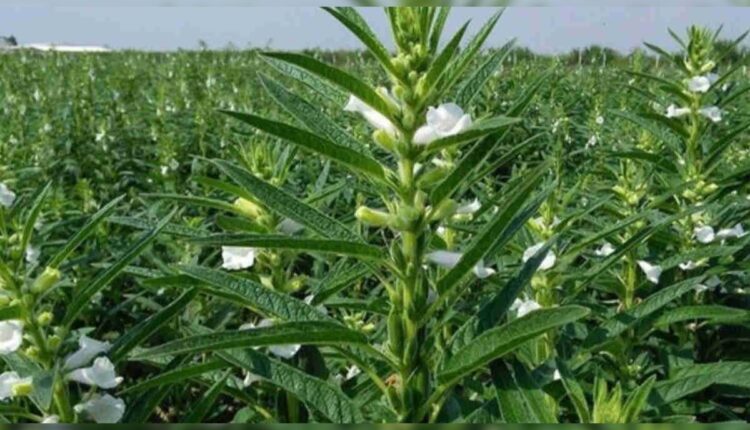Advanced Varieties in Sesame Cultivation: 5 advanced varieties in sesame cultivation that will increase the yield of sesame
By adopting advanced varieties in sesame cultivation, farmers can get more yield and better oil quality in less time.
Sesame Cultivation: Sesame is a traditional but important oilseed crop in India, which is used not only for domestic consumption but also at the industrial level. Its demand remains constant both in the country and abroad, but the biggest challenge for farmers is related to the low yield of sesame. Its only permanent solution is to adopt advanced varieties in sesame cultivation. These varieties developed through modern research and scientific methods give more production than traditional seeds and are also more tolerant to climate change. In this blog, we will know in detail which are the advanced varieties that can bring change in sesame cultivation.
Why are advanced seeds needed? (Why are improved seeds needed?)
In many areas of the country, sesame cultivation has been done using traditional methods. This keeps the production limited and the cost is high. But as the uncertainty of weather, pest infestation and soil conditions are changing, traditional varieties are no longer as efficient. In such a situation, advanced varieties in sesame cultivation not only help in dealing with these challenges, but it can also double the income of farmers. Improved seeds are ready early, give good production even with less irrigation and their grains have high oil content.
TC 25: Early maturing and high yielding variety
TC 25 is an improved variety that gets ready in about 90 to 100 days. Plants of this variety are of medium height and start flowering within 30 to 35 days. On an average, each plant has 4 to 6 branches and 65 to 75 capsules (pods) are formed in it, which grow simultaneously from the top to the bottom of the plant. The average yield of this variety has been found to be 4.25 to 4.50 quintals per hectare.
The colour of its seeds is white and the oil content in them is 48 to 49 percent. Not only this, the protein content in its grains is also 26 to 27 percent, which makes it useful from the nutritional point of view. Farmers can get better production from advanced varieties in sesame cultivation such as TC 25.
RT 127: A strong and quick-ripening variety
RT 127 is a great option for those farmers who are looking for an early-ripening variety. This variety is ready in just 75 to 85 days. Its seeds are brown in colour and the oil content in them is between 45 to 47 percent. Apart from this, protein is also found up to 21 percent. Its average yield can be 6 to 9 quintals per hectare, which makes it very productive.
This variety has been found to be tolerant to blight, leaf fall and other common diseases. Advanced varieties in sesame cultivation such as RT 127 have the ability to give more yield to farmers in less time.
RT 46: More branched and multipurpose variety
RT 46 variety plants are 100 to 125 centimeters tall and their leaves and pods are attached close to each other. In this variety too, flowers start coming within 35 to 40 days and on an average 4 to 6 branches emerge. About 73 to 90 capsules are formed in a plant, which makes it a high yielding variety. Its average yield has been found to be 6.00 to 8.00 quintals per hectare.
The colour of its seeds is white and the oil content is up to 49 percent. This variety is very beneficial for those farmers who want both more oil and yield. RT 46 is definitely a strong name in Advanced Varieties in Sesame Cultivation.
R.T. 125: Variety with balanced growth and low loss
R.T. 125 variety ripens in 80 to 85 days and the height of its plants ranges from 100 to 120 cm. The biggest feature of this variety is that all the pods ripen together, which makes them easy to harvest and the loss due to falling is also very less. Its average yield has been seen to be 6 to 8 quintals per hectare. By adopting this variety, farmers can take full advantage of the benefits of advanced varieties in sesame cultivation.
T. 13: Variety with high amount of oil and protein
Plants of T. 13 variety grow to a height of about 100 to 125 cm and flowers appear in them in 35 to 40 days. This variety ripens completely in 90 to 100 days. About 60 capsules are found in a plant of this variety and the seeds are white in color. Its specialty is that the oil content in it is 49 percent and protein is up to 24 percent. Its average yield can also be 5 to 7 quintals per hectare. T. 13 is also a very useful option in Advanced Varieties in Sesame Cultivation in terms of nutrition and production.
How to choose advanced varieties in sesame cultivation?
It is important for any farmer to first understand which variety will be most suitable according to the soil, weather and water availability of their field. For this, they can consult the local Krishi Vigyan Kendra or agricultural experts. Always buy seeds from a certified source and follow the time and distance fixed for sowing. This maintains the quality of the seed and brings uniformity in the crop.
Conclusion
In today’s changing times, it is important that farmers move forward from old methods to make farming sustainable and profitable. Adopting advanced varieties in sesame cultivation will not only increase the yield, but will also increase the chances of getting good prices in the market. Better yield, low cost, high oil content and disease resistance – all these benefits are possible only when farmers choose varieties based on modern scientific methods and research. The time has come for farmers to make their future safe and prosperous by connecting farming with science.
Contact details: If farmers want to share information or experiences related to farming with us, then they can do this by calling us on the phone number 9599273766 or by writing an email to [email protected] or by sending your recording. Through Kisan of India, we will convey your message to the people, because we believe that if the farmers are advanced then the country is happy.



